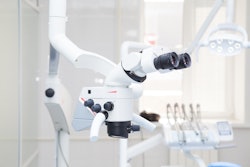
Guided endodontics may lead to significantly better clinical outcomes than freehand treatment with fewer technical failures, according to a study recently published in the International Endodontic Journal.
However, this procedure should be performed by an experienced endodontist using a dental microscope, the authors wrote.
"Guided endodontics presented a statistically significant better outcome than freehanded treatment," wrote the authors, led by Andres Torres of the University of Leuven in Belgium (Int Endod J, November 6, 2024).
To compare the methods, a controlled clinical trial that included 133 teeth from 128 patients, with 60 teeth treated using guided endodontics and 73 with freehand techniques was conducted. Each patient underwent a thorough intraoral examination and a periapical radiograph was taken for assessment. A preoperative cone-beam computed tomography scan was then taken for further evaluation, they wrote.
The primary outcome for both groups was evaluated as either canal found, canal not found, or perforation. The secondary outcome assessed the qualitative accuracy of the drill path as optimal precision, acceptable precision, or technical failure. Patients were followed up yearly. Descriptive statistics were performed on patient demographics and healing outcomes along with statistical analyses for each outcome variable.
In the guided endodontics group, the root canal was in 59 out of 60 teeth (98.3%). In one case (a maxillary canine), the canal could not be found, and the patient was scheduled for endodontic microsurgery. No perforations occurred. In the freehand treatment group, the root canal was successfully located in 59 out of 73 teeth (81%), according to the results.
However, in seven teeth (9.5%) the canal was not located, and perforations occurred in another seven teeth (9.5%). An analysis of all data without matching showed that guided endodontics achieved a statistically significantly better outcome than freehand treatment (p < .05). This result was consistent when examining only matched pairs of teeth (n = 54) and excluding unmatched data (p < .05).
Additionally, of the 60 teeth treated with guided endodontics, 49 showed optimal precision with a centered drill path. Acceptable precision, requiring a correction to locate the canal, was achieved in 10 teeth (eight maxillary incisors and two lower premolars). One technical failure occurred when the root canal could not be located, according to the results.
The study had limitations. It lacked patient randomization, addressed by selecting a control group from the same center and performing a matched pair analysis, the authors wrote.
"Guided endodontics showed a statistically significant better outcome than freehanded treatment resulting in less technical failures," Torres et al wrote.




















